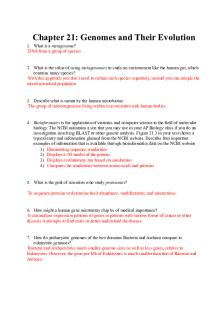Guided Reading Chapter 2 PDF

| Title | Guided Reading Chapter 2 |
|---|---|
| Author | Ellie Henry |
| Course | How Things Work |
| Institution | University of North Carolina at Chapel Hill |
| Pages | 2 |
| File Size | 76.6 KB |
| File Type | |
| Total Downloads | 5 |
| Total Views | 168 |
Summary
guided reading...
Description
Chapter 2.3: Bumper Cars Vocabulary (short definition/use in a sentence) •
•
•
• • •
Linear Momentum o The measure of an object’s translational impetus or tenacity o Its determination to keep moving the way it is currently moving Impulse o How momentum is transferred, the force exerted on an object for a certain amount of time Angular Momentum o Measure of an object’s rotational impetus or tenacity o Its determination to keep rotating the way it is currently rotating Angular Impulse o A torque exerted on an object for a certain amount of time Conserved quantity Gradient o Characterizes how some physical quantity changes gradually with position
Units (what quantity is measured in the following) • • •
Kilogram-meter per second (kg m/s): o Unit of momentum Newton second (Ns): o Unit of impulse Kilogram-meter squared per second (kg m2/s o Unit of angular momentum
Equations and physical laws (express in words) •
• • •
Linear Momentum o Momentum = mass x velocity o p = m*v Impulse o Impulse = force x time Angular Momentum o Angular momentum = rotational mass x angular velocity Angular Impulse o Angular impulse = torque x time
Example problems/questions: 1. If a 1000kg car is traveling 50 mph (coasting on ice – so no friction), how many .1g bugs who are stationary does it need to hit to slow down to 1 mph? a. The car’s kinetic energy is 500,000 kg m^2/s^2, so 5,000,000 .1g bugs would be able to bring the car to 1 mph.
2. More bowling! When you first let go of the ball, it is not rotating and skids down the alley. a. What happens to its kinetic energy as it skids? i. Friction between the ball and the bowling alley creates energy in the form of heat, which means that there is less kinetic energy. b. The ball will start to rotate – what provides the torque that starts that rotation? i. Friction provides the torque that keeps the ball rotating, because eventually the ball stops skidding and starts rolling c. When the ball strikes the pins, the pins go flying *and* the ball continues moving forward. Why doesn’t the ball bounce off the pins? i. The mass of the ball is much greater than the mass of the pins, so even though the pins push back on the ball with an equal and opposite force the ball continues to move forward....
Similar Free PDFs

Guided Reading Chapter 2
- 2 Pages

Chapter 13 Guided Reading
- 5 Pages

Chapter 8 Guided Reading
- 3 Pages

Guided Reading Chapter 7
- 2 Pages

Chapter 21 Guided Reading
- 5 Pages

Guided Reading Chapter 24
- 3 Pages

Guided Reading Chapter 9
- 8 Pages

Guided Reading Assignment #2
- 2 Pages

Guided Reading #2 - GRQ
- 1 Pages

Amsco Guided Reading Chapter 3
- 9 Pages

Amsco Guided Reading Chapter 4
- 9 Pages

Guided Reading Questions Ch 2
- 2 Pages

Guided Reading Questions #5
- 2 Pages

Bio guided reading 11
- 6 Pages
Popular Institutions
- Tinajero National High School - Annex
- Politeknik Caltex Riau
- Yokohama City University
- SGT University
- University of Al-Qadisiyah
- Divine Word College of Vigan
- Techniek College Rotterdam
- Universidade de Santiago
- Universiti Teknologi MARA Cawangan Johor Kampus Pasir Gudang
- Poltekkes Kemenkes Yogyakarta
- Baguio City National High School
- Colegio san marcos
- preparatoria uno
- Centro de Bachillerato Tecnológico Industrial y de Servicios No. 107
- Dalian Maritime University
- Quang Trung Secondary School
- Colegio Tecnológico en Informática
- Corporación Regional de Educación Superior
- Grupo CEDVA
- Dar Al Uloom University
- Centro de Estudios Preuniversitarios de la Universidad Nacional de Ingeniería
- 上智大学
- Aakash International School, Nuna Majara
- San Felipe Neri Catholic School
- Kang Chiao International School - New Taipei City
- Misamis Occidental National High School
- Institución Educativa Escuela Normal Juan Ladrilleros
- Kolehiyo ng Pantukan
- Batanes State College
- Instituto Continental
- Sekolah Menengah Kejuruan Kesehatan Kaltara (Tarakan)
- Colegio de La Inmaculada Concepcion - Cebu

